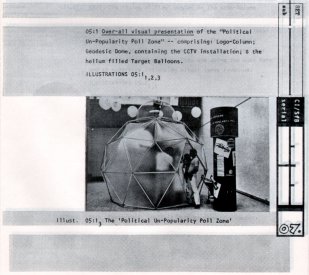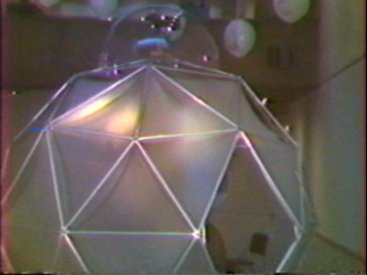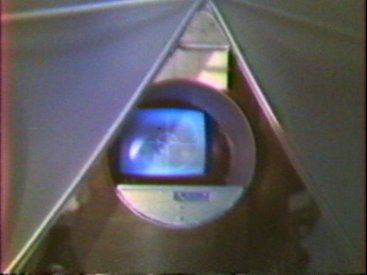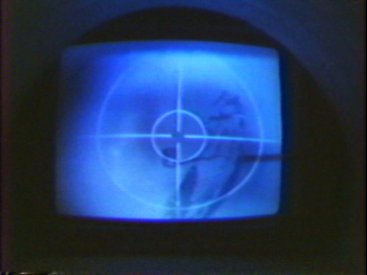Michael Nicholson was born in 1916 in the UK. He studied at City and Guilds School of Art, London (1938–39); LCC, Camberwell School of Arts and Crafts, London (1948); and LCC Central School of Arts and Crafts, London (1949). He moved to New Zealand in the post-war period, securing a position at the Auckland university, where he taught in the schools of Architecture and Art. At the time of the 1976 Biennale of Sydney, Nicholson lived and worked in Sydney, Australia.
After participating in the Object and Image exhibition (curated by Colin McCahon at the Auckland City Gallery in 1954), he took a year's study leave and re-located to Sydney. He participated in shows at the Watters Gallery in Sydney, the Mildura Sculpture Triennials and the 1976 Biennale of Sydney, where he installed Poli-Poll-Pool-Shots.
In 1988 he returned to live in Wellington, where he continues to make and exhibit visual music projects.http://circuit.org.nz/artist/michael-nicholson
Poli-Poll-Pool-Shots (1976)
Video installation, 3m radius, geodesic dome, CCTV system, monitor, balloons.
An interactive video installation constructed inside a geodesic dome (supplied by Tony Edye). On top of the dome was a perspex hemisphere with a video camera mounted on a remote controlled pan/tilt tripod head. Above the dome and offset from it were a number of helium-filled balloons with images of various politicians printed onto them. Prominent was an image of Malcolm Fraser, the then much-disliked Prime Minister of Australia who had recently usurped the much-loved Gough Whitlam. (However, the current view of Fraser is one of a well respected and highly moral elder statesman.)
Inside the dome a monitor showed the image from the video camera which could be pointed with a joy stick at one or another of the balloons. A count was kept of the politicians selected by the audience for their “pool-shots” and this became an informal poll of the most disliked politicians of the period.
The Sydney Morning Herald (11 November 1976) wrote of Nicholson’s installation:
“Viewers will be able to enter the dome and operate a closed-circuit television system to bring their least loved political figure (either Malcolm Fraser, Gough Whitlam, Sir John Kerr or Bob Hawke) on to a screen.
A tally of on screen time for each figure will be shown on another screen indicating, according to Mr. Nicholson, their non-popularity rating.”
In a booklet a booklet titled “DMT/2 Feed-Back-Loop: Poli-Poll-Pool-Shots Appraisal Document”, Nicholson documents his approach to making the work and describes his strategy:
“Develop an iconic image of a P R 0 B E device, such that it is experienced by the subject as a medium for existential ‘play’, focusing concern on some ‘tension = real-need state’ of the man-environment field, where direct action to resolve the tension is ruled out — ie, where an intolerable situation exists in conjunction with zero or very small conventional resources.
03:7 The strategy, on the level of human contact, has been to offset the loneliness and alienation involved in working out the reductive configurations — texts, and non-figurative formalist works — with socially concerned, audience-participatory works, of which the Poli-Poll-Pool-Shots video sculpture is one example.
03:8 Such formulations are generally media oriented. The system of reference to this expression, in the terminology of the studio, can perhaps be worked out with the assistance of the following quote from an earlier text:
In the ABC TV Documentary on the Biennale of Sydney, the Poli-Poll-Pool-Shots video sculpture was correctly coupled, by the exhibition director, Tom McCullough, with another work, by the Canadian artist Les Levine, with which it shares one important idea in common, the proposition that since the minds of the people are programmed, predominantly, by the media, it follows that an artist with something to say, should channel his message, as an influence affecting the media ‘soft-wear’ program. ‘Media-Orientation’, the property which this work shares with Les Levine’s Bear Media Monument implies that the work has its greatest impact in ‘time on air’, ‘viewing time’, ‘column inches’; cassettes distributed; video-tapes played back, etc, that are generated as extensions of the primitive ‘exhibited’ form.”
Nicholson then explains that the “central concern” of Poli-Poll-Pool-Shots is:
“an ‘exact-opposite-probe’ in that triangular domain of negative tensions, which contains: 1) the apathetic political consciousness; 2) this same consciousness, sanctioned by the customary balloting (secret voting) ritual; and 3) this consciousness, manipulated by secretly devised ‘public opinion polls’ (amongst the many other manipulative devices in use for population control) — a domain in which peoples are seen to be set up as easy targets for fascist regimes, when their time is ripe.”











